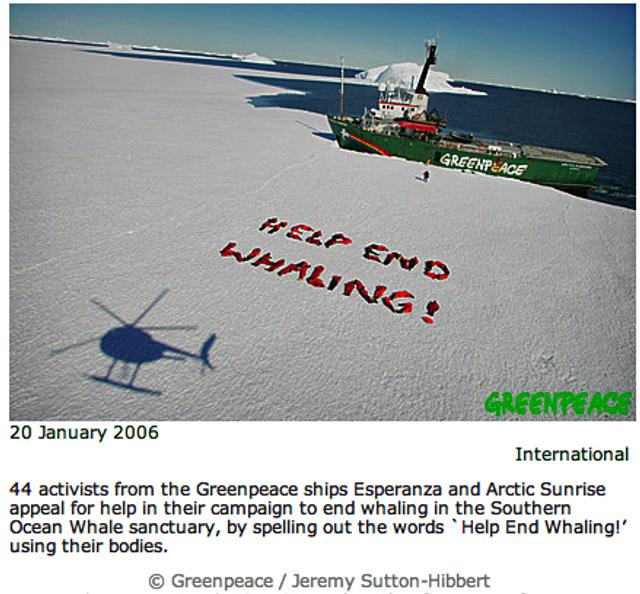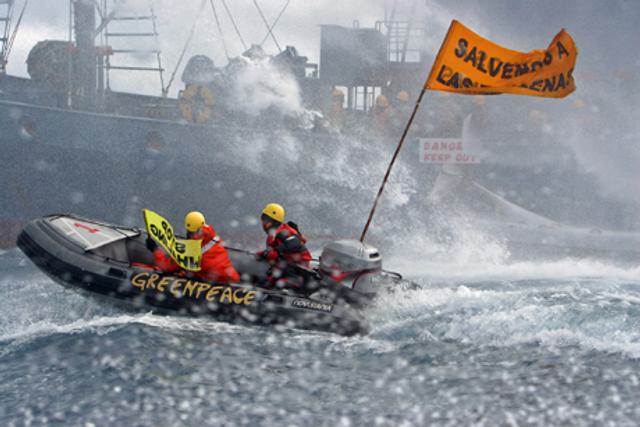Greenpeace: the virtual march for whales
- Exhibited by
- Marcelo Iniarra.
- Added
- June 12, 2011
- Medium of Communication
- Event, online, telephone
- Target Audience
- Awareness.
- Type of Charity
- Environmental / animals
- Country of Origin
- Argentina
- Date of first appearance
- 2005
SOFII’s view
Welcome to a big idea, one made possible only by the Internet, cell phone technology and by a spirit of adventure backed by the willingness to take a risk. If only whales everywhere could realise the great things that are being done all around the world by ordinary people to protect them and make this planet a safe place for them and their descendents for all time. Assuming that whales can be amazed, they surely would be. But who thought of organising this event on such a scale, with such attendant publicity and fundraising? They deserve an award, whoever they are.
Creator / originator
Marcelo Innara, Greenpeace Argentina.
Summary / objectives
The ‘no whaling virtual march’ was a Greenpeace global campaign that mobilised, in an innovative way, more than 61,000 people from 152 countries in just 33 days.
The objective of the campaign was to protest against the South Korean Government’s intention to re-open commercial whaling at the International Whaling Commission (IWC) 2005 annual meeting they would be hosting.
Background
The virtual march represents the real power of community: 61,000 people participated in the campaign, which lasted for only 33 days. Our project was to encourage people to take part in a group action through the latest technology. We joined the power of the internet to cell phones and traditional media to give people all over the world the opportunity to be in South Korea protesting against commercial whaling, no matter where they lived and from the privacy of their own home. The virtual march created an online and offline worldwide community joined together around the same ethical cause.
We had to coordinate the work between all Greenpeace offices around the world to carry out 11 virtual march sites in five languages, as well as the press action, the marketing, the direct dialogue campaign and TV spots.
This project also gave people an incentive to organise themselves and manage their own campaign at work, school, clubs, or public places. People around the world took the Greenpeace cause and mobilised others in their towns and countries to add more and more people to the march. Nearly 35 per cent of the pictures that were sent came from personal campaigns.
Moreover, through a viral online marketing strategy, people were encouraged to incorporate the virtual march on their own blogs, websites and active online communities, therefore allowing others to participate and discuss, in many different forums, commercial whaling and the Greenpeace action.
Based on the success of photo-logs and photo-communities, such as Orkut and Flickr, we decided to use this well-known technology to improve the virtual march; in every one we promoted the Greenpeace activism conception: to protest against commercial whaling through pictures, to take the power to change a negative environmental situation.
As part of the virtual march strategy, the projection of photographs onto the side of the building where the IWC meeting took place made the difference between the virtual march and other similar projects.
We gave people the opportunity to send pictures from their phone. Photographs taken by a mobile phone and the MMS (multi media messaging service) technology were also commonly used. The possibility to upload those contents directly from the phone to a website is probably the most innovative technique used by the virtual march. The virtual march was already using mobile phone blogs and posting photos and text directly from mobiles almost one year before people everywhere started talking about the possibility of doing it. At least twice a day, even though the system was not automatic, all the contents coming from mobile phones were published on our website.
Special characteristics
The virtual march had the power to reach across boundaries of culture, language and time to influence thousands of people all over the world because it used the same techniques and tools that ordinary people are using every day and put them together with Greenpeace activism.
Results
The international pressure upon the Korean government gave participants a great victory. South Korea didn’t follow the Japanese Government in their policy at the IWC and the resumption of commercial whaling was staved off by 29 votes to 23.
Merits
Greenpeace recognised that people all over the world could make an incredible contribution to their campaign to stop whaling using so-called new technology. Through this virtual march, a national Government reversed its decision to try and start commercial whaling again.
Follow-up of the project
What’s Marcelo up to now? If you have not already subscribed, find out now at www.marceloiniarra.com.
 View original image
View original image


Also in Categories
-
-






















